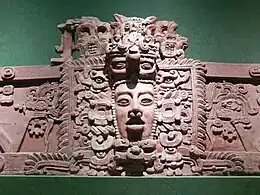Museo Miraflores
The Museo Miraflores is an archaeological museum in Guatemala City, dedicated to the display of artefacts from the ancient Maya city of Kaminaljuyu.[1] The museum is open from Tuesday through to Sunday.[2]
| Established | 2002 |
|---|---|
| Location | Guatemala City |
| Coordinates | 14°37′13.50″N 90°33′15.79″W |
| Type | archaeological museum |
| Website | museomiraflores |

The museum was founded in 2002.[3] The museum is located in Zone 11 of Guatemala City, in the southern part of the area once covered by the Maya city of Kaminaljuyu.[4] It covers an area of approximately 1,200 square metres (13,000 sq ft).[4] Within the grounds of the museum are three preserved mounds.[4]
The modern museum is located in a shopping area outside the city centre.[5] It is privately owned and run by the Fundación Miraflores ("Miraflores Foundation"), a for-profit organisation.[6] The museum is described with labels in Spanish and usually English too.[5]
Facilities
The entrance hall to the museum has a map of the ancient city set into the floor, overlaid with glass marked with the streets of modern Guatemala City.[7] The museum has a permanent exhibition hall, a temporary exhibition hall and a mezanine with a display of 60 archaeological photographs taken between 1994 and 1996.[7] The museum also has a shop and a cafeteria and is the venue for workshops, conferences and courses.[2]
The mounds within the museum garden are three of twenty-five ancient mounds surviving from Kaminaljuyu that are located on private property.[8] They are Structures B-V-3, B-V-4 and B-V-5;[8] they have been provided with information plaques.[9]
Collection
| This article is part of a series on the |
| Maya civilization |
|---|
 |
|
| History |
| Preclassic Maya |
| Classic Maya collapse |
| Spanish conquest of the Maya |
|
|
The collection includes approximately 500 artefacts excavated from Kaminaljuyu.[4] Most of the artefacts were excavated from Kaminaljuyu during the period 1994 to 1996 by the Proyecto Miraflores ("Miraflores Project").[10] However, not all the artefacts on display have a local origin, and some have come from further afield in Guatemala, especially from pre-Columbian sites that had contact with Kaminaljuyu.[10] Among the artefacts in the collection are a mosaic mask consisting of 19 pieces of jade of unknown provenance and a sculpted stone atlante column.[11] Other collections at the museum include indigenous textiles from the Guatemalan Highlands and monthly displays of modern art.[10]
Notes
- Museo Miraflores (1). Anonymous 2011.
- REDCAMUS.
- Herrera 2011.
- Museo Miraflores (1).
- "Museo Miraflores". Lonely Planet. Retrieved 9 February 2011.
- Museo Miraflores (3).
- Museo Miraflores (2).
- Crasborn et al 2004, p.190.
- Crasborn et al 2004, p.195.
- Torres 2009.
- Anonymous 2011.
References
- Anonymous (2011-01-24). "Piezas emblemáticas" [Emblematic pieces]. El Periódico (in Spanish). Guatemala City: Aldea Global, S.A. Retrieved 2011-02-08.
- Crasborn, José; Elizabeth Marroquín; Alexander Urízar; Edgar Hernández; Camilo Luin (2004). "La agonía del Cerro de Los Muertos: Kaminaljuyu hacia el siglo XXI" (PDF). XVII Simposio de Investigaciones Arqueológicas en Guatemala, 2003 (edited by J.P. Laporte, B. Arroyo, H. Escobedo and H. Mejía) (in Spanish). Guatemala City: Museo Nacional de Arqueología y Etnología: 188–202. Retrieved 2011-02-09.
- Herrera, Lucía (2011-01-27). "Un tesoro en cada página" [A treasure on every page]. Prensa Libre (in Spanish). Guatemala City. Retrieved 2011-02-08.
- Museo Miraflores (1). "Museo" (in Spanish). Guatemala City: Museo Miraflores. Retrieved 2011-02-08.
- Museo Miraflores (2). "Tour" (in Spanish). Guatemala City: Museo Miraflores. Retrieved 2011-02-08.
- Museo Miraflores (3). "Fundación Miraflores" (in Spanish). Guatemala City: Museo Miraflores. Retrieved 2011-02-09.
- REDCAMUS. "Museo Miraflores" (in Spanish). Red Centroamericana de Museos (REDCAMUS). Retrieved 2011-02-09.
- Torres, Estuardo (2009). "Museo Miraflores" (in Spanish). Guatemala City: Ministerio de Cultura y Deportes. Archived from the original on 2011-07-19. Retrieved 2011-02-08.